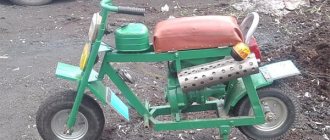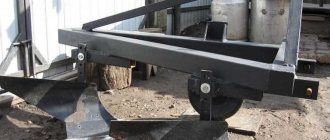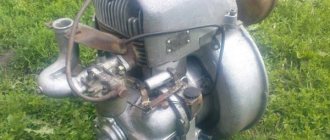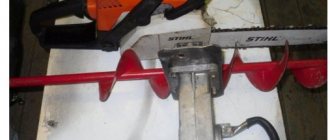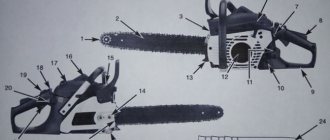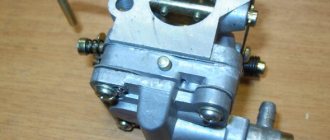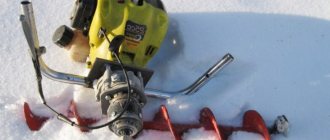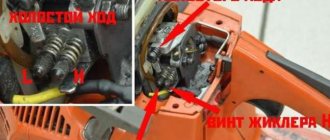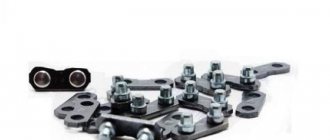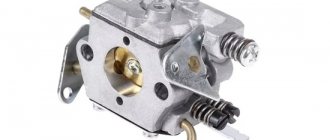When should the work be done?
When using a chainsaw intensively, sharpening is carried out quite often, often several times in one day. Particular attention should be paid to the fact that the contact of the chain with the ground significantly speeds up the process. Therefore, chainsaws must be used in such a way as to eliminate the possibility of contact between the chain and the ground. After several contacts, the chips will be very small, and the chain will go deeper into the material slightly. When considering this issue, it can be noted: the more often you have to sharpen the chainsaw chain, the less metal layer is removed. Also, if you sharpen frequently, the service life of the cutting element of the chainsaw will increase significantly. The main condition can be called the correct execution of the work, if you do it yourself. The procedure can only be performed correctly if you have a special machine. A sign that the cutting element of a hand chainsaw has become dull is a significant feed force. Properly sharpened chains determine a significant reduction in the feed force, that is, the chainsaws enter easily with a little pressure. Another sign of the need to sharpen chains is the production of very small chips. Sharpening a chainsaw when the signs in question appear is mandatory. Sharpening of chains is carried out in order to greatly reduce the tension in the body, reduce the cyclic load rate and fuel consumption. Also, if you do not sharpen the teeth of the chains on time, there is a possibility of increased wear of all components, as a result of which the service life of the hand chainsaw is reduced.
PowerSharp technology
If your chain is PowerSharp compatible, you can save time and effort. Sharpening occurs without removal from the tire in just a few seconds. The system includes:
- sharpening device;
- abrasive bar;
- saw bar.
Let's figure out how to sharpen a chainsaw chain using PowerSharp in just three steps:
- Install the chain with the bar;
- Secure the beam installed directly on the tire;
- Place the end of the saw somewhere and run the equipment for a few seconds.
Compliance with all recommendations will allow you to avoid damage to the chain and carry out the operation in compliance with technological requirements.
Geometry Features
In order to sharpen correctly with your own hands, even if you use a machine, you should know the geometry of the tooth. Its constituent elements include:
- Spatula.
- The main link.
- Depth limiter.
In this case, the tooth blade consists of the following elements:
- End blade.
- Top blade.
You need to sharpen correctly with your own hands, taking into account the fact that the end and top blades must be positioned correctly relative to each other to ensure the best cutting performance. The back of the tooth forms a certain angle of the upper blade. A similar angle is formed to cut the blades into the material. Sharpening with your own hands should also take into account the fact that the blade has a narrowing towards the back - this design feature forms the angle of the end blade. It is created to ensure lateral cutting of chips.
Chainsaw chain tooth
The sliding surface and the end part of the blade forms the rake angle. In this case, the angle has a fixed value; it varies from 60 to 85 degrees. If you sharpen the teeth with your own hands, it is worth considering that the upper blade is the main one, and the angle formed by it is the most important angle. To summarize, when considering the issue of geometry features, we note that the sharpening angle can vary depending on the conditions of use. The basic rule that should be followed when sharpening a tooth with your own hands is the following: the higher the angle, the greater the performance of the chainsaw, but reducing the value ensures smoother running of the blades, reduced vibration and increased service life. It is worth sharpening taking into account that the indicator should be in the range from 25 to 35 degrees. An exception is the version of the blade, which is intended for longitudinal cutting - many manufacturers of the chainsaw cutting element can withstand 10 degrees.
Requirements for the setting of hacksaw teeth
When bending the cutters one at a time on both sides of the canvas, maintain a certain value that can be set on a homemade device.
The width of the wiring depends on the type of wood.
Soft and damp wood requires a larger angle of inclination than dry wood.
As a rule, hand tools work effectively with an average value of 0.2-0.3 mm.
At the same time, the total value should not exceed the width of the canvas.
In addition, the same nature of the bend on each side is observed.
The wiring for the hacksaw is checked visually or using a caliper.
Pay attention to the size of the tooth - the height of the incisor is especially important
Alternative finishing methods
You can use the ceramic edge of a plate or mug as a sharpening stone. Just turn them over and make sure the edge on the bottom is rough.
Sets of kitchen knives today certainly include musat - a steel rod with longitudinal grooves and a handle. It is not suitable for sharpening, but it allows you to keep the blade sharp longer. Indeed, rubbing the blade with musat a couple of times before and after work is a much less time-consuming process than full sharpening.
When traveling, looking for special stones on which to sharpen hardened steel is not the easiest task. Therefore, hunters carry miniature whetstones with them, and often bring them to the sheath in which the knife is stored.
Sharpening
If the block is double-sided, use the rougher side first. This will allow you to quickly remove the required layer of steel. For proper sharpening of a blade, the key is the angle at which the blade is positioned to the block. An angle of 20 degrees is considered ideal, but experienced people advise you to approach this creatively - depending on the type of knife and what work it will be used for.
Hunting and folding knives are sharpened at an angle of 30-35 degrees for a sharper cutting edge, or at an angle of 40-45 degrees to increase resistance to dullness. Tactical knives - 25–40 degrees. Professional chef's, boning and fillet knives are sharpened at an angle of 25 degrees, and home kitchen knives are sharpened at an angle of 25–30, while Japanese kitchen knives are sharpened at an angle of 10–20 degrees; straight razors - 10–15 degrees. The main thing is to remember: the smaller the sharpening angle, the sharper the knife, and the larger the sharpening angle, the longer it will remain sharp.
You need to sharpen the knife using smooth movements, slightly lifting the handle when it comes to sharpening the curve of the blade. This will allow you to maintain the same sharpening angle throughout the cutting edge. In addition, the blade must be guided so that the direction of movement is always perpendicular to the cutting edge.
That is why devices popular among housewives, consisting of a piece of plastic in which two disks of abrasive material are fixed, are not suitable for proper sharpening. They sharpen a knife quickly, but blades sharpened in this way will also become dull very soon.
READ How to Disassemble a Small Grinder
You don’t need to put all your might on the blade, but you shouldn’t stroke the sharpening stone with a knife either—it’s important to find a happy medium. The blade should be sharpened until a clearly visible “burr” appears on the back of the cutting edge.
In this case, you can begin processing the back side of the blade.
Saw design
To better understand what a chainsaw is and how it works, it is advisable to know how it works.
By the way, it would be more correct to call the cutting tool of a chainsaw a saw chain.
The first saw chains appeared at the beginning of the twentieth century. The designers did not begin to puzzle; they simply mounted teeth on the chain, which quickly lost their functionality. In appearance they resembled those that stand on hand hacksaws for wood. Sharpening such a chainsaw caused great difficulties. But repeated attempts to create the perfect saw chain were crowned with success only in 1947.
Chainsaw device
This chainsaw has links with an L-shaped cut. Modern chains are, in fact, the direct ancestors of this development.
If during work the cutting speed begins to decrease, the chainsaw in the hands of the master begins to “walk”, then most likely the saw chain has lost its operational properties, that is, it has become dull and measures must be taken to restore them.
Why does the tool become dull?
Each chainsaw has a certain durability period. This is the time from the start of work with a new tool until it becomes inoperable.
Destruction or wear of a cutting tool intended for woodworking occurs due to the impact of a set of forces arising during the cutting process. One of the key ones is friction force. Dulling of the saw chain occurs due to prolonged work, due to the use of a chainsaw for purposes other than its intended purpose.
The amount of wear can be defined as a measure of weight, measured in milligrams. Wear is a parameter that shows a change in the characteristics of the shape and size of the cutting blade. The change in geometric parameters that occurs during cutting, and there is no linear wear, is called blunting.
There are parameters on the basis of which a decision is made about the possibility of further operation of the tool. In particular, when examining the teeth of a saw chain, it is necessary to pay attention to the edges of the front and rear surfaces, the height of the blade, and the wear area. If they are in unsatisfactory condition, it means it’s time to sharpen the chainsaw.
Signs that the saw has lost its sharpness include the following:
- Reducing chip size.
- Using more force to do the job.
When to sharpen and how to find out about it
After examining the saw chain, the master decides whether it is time to sharpen the tool or not.
As a rule, the saw chain loses its performance properties during intensive work. It can get to the point where the chain will have to be sharpened several times in one day. The cause may also be contact of the saw with the ground. In fact, just scrape the saw chain across the ground a few times and you can stop all work. The chainsaw will simply stop going into the tree. By the way, one of the signs of a dull saw is the appearance of small chips.
Dull chainsaw chain
The sooner measures are taken to sharpen the chain, the longer it will last. It is quite easy to understand when resharpening is required. There will be a feed change. A chain with properly sharpened teeth will retract even with a small force, but if during operation you have to exert a greater feeding force, then this means only one thing, the teeth have lost their sharpness.
Do not use a blunt chain. By the way, this is a safety requirement. And the process will require significant muscular effort from the lumberjack. As a result, this leads to a decrease in cut quality, an increase in the amount of fuel used and accelerated chain wear.
Signs of wear on a chainsaw cutting edge
The performance of a chainsaw largely depends on the condition of its chain. To use a chainsaw effectively and safely, its chain must be sharp.
The importance of properly sharpening a chain is greater than the importance of using a powerful motor. Intensive use of this tool leads to rapid wear of the chain
In some situations, the need to sharpen a chain occurs several times during one day. The more often blunt teeth are sharpened, the less metal has to be removed during sharpening, thereby extending the service life of the saw chain.
To determine the moment when the angles cease to meet the most effective parameters, it is necessary to take into account several signs:
- The chain begins to stretch and sag slightly. As a result, the functioning of the tool deteriorates and the sawing process slows down. To achieve the desired result, you have to put in extra effort.
- Sawing workpieces of the same size is slower than before. There is a significant decrease in productivity. The work that used to take two hours now takes four hours.
- The type of sawdust changes. They become smaller, sharper and uneven. When the chain is in proper condition, the sawdust appears as rectangular elements that are indistinguishable from each other.
File
A file can be used to carry out the work in question. A file is used to remove the required layer of metal from the surface. A special set was created for this case:
- The file is round and has an unusual holder.
- Flat file needed to adjust the depth limit.
- Hook.
- Special template.
The round file holder is created along with marking lines that are used to position the tool correctly. During operation, the plate itself comes into contact with the depth stop and the surface of the blades, and the file moves around and removes a layer of metal. The use of a special holder with a file allows you to ensure the correct fit of the tools to the surface being processed. You should only use a file that is designed to perform such work.
Angles of inclination when sharpening with a file
The rules of work include:
- The same number of movements should be done.
- It is necessary to control the force of pressure on the surface during processing.
- The template, which is used together with the file, allows you to maintain important sharpening parameters.
With different lengths, uneven travel and the formation of cracks in the material are observed. If the length indicator is not the same at the start of processing, then all cutting teeth are filed according to the indicator of the smallest one.
Application of special machines
It is not always possible to use a hand tool with a template. For example, if the cutting edge comes into contact with the ground during operation, there is a possibility of its deformation. In this situation, a special machine is used. The machine comes in two types:
- Mechanical.
- Electric.
The power saw has a design that looks like a bow saw, but with a round file. The machine can be used to level the length of all edges and restore the correct geometry. The machine in question has a complex system for setting processing parameters. Sharpening is performed in approximately 2-3 movements, after which the machine is installed in a new location.
The electric machine is easy to use. A special adjustment system allows you to correctly position the surface to be treated, as well as position the disc with high accuracy. Some models have an automatic vice clamping system when the disk is lowered. The cost of the electric version is slightly higher, but at the same time the performance increases significantly and the most accurate result can be achieved.
PDF Guide to Sharpening Stihl Saw Chains
Consumables
In electric sharpeners, special wheels are used to sharpen chains, which are gradually ground down.
Instructions for replacing the wheel are in the user manual, but we’ll talk about the characteristics that need to be taken into account when buying a new one.
The characteristics of the grinding wheel are as follows:
- grain size (the number of grains per square centimeter, the fewer grains, the smoother the sharpening);
- outside diameter;
- bore diameter;
- thickness.
Important: when purchasing a new wheel for a sharpening machine, you must make sure that the diameter of the mounting hole and the maximum diameter of the wheel correspond to the same parameters of the machine, otherwise the wheel will not fit.
The diameter of the mounting hole of the circle must exactly match the mounting sleeve of the machine; the outer diameter can be chosen a little smaller, this is not critical.
The choice of grinding wheel thickness depends on the size of the chain that you plan to sharpen. Circles with a thickness of 3.2 and 4.5 mm are mainly used.
A consumable material for manual machines is a file.
On our website you can find an article that describes in detail how to choose a file for sharpening a chain; you need to select a file for a manual machine in the same way.
How to properly sharpen a chainsaw chain with your own hands. Step-by-step instruction
Bringing a chain into working condition has its own characteristics. They are determined by the configuration of the tooth. It includes two edges, located - one at the top and the other at the bottom. Moreover, the edge located towards the top has a slope at a given angle. In fact, the tooth, both in geometry and in its operating principle, is similar to the blade of a carpenter’s plane.
Manual chain sharpening diagram
For competent sharpening, the master must understand the structure of the tooth.
Teeth parameters
The tooth structure consists of:
- grounds;
- shoulder blades;
- limiter.
Two cutting edges are formed on the blade, one is placed on a horizontal plane, the other at an angle. To obtain the required parameters, the blades are sharpened at the angle specified in the technical specifications. The rake angle is sharpened in the range from 60 to 85 °.
The clearance angle indicates the backward tilt of the upper blade. It lies in the range of 50 to 60°. The blade located on top is considered the main one; the rear angle in this design is very important. It is difficult to measure; if the sharpening rules are followed and the geometric parameters are observed, it is formed in the specified range.
Teeth
The corners are sharpened depending on the use of the tool. The main rule is that the larger the angle, the greater the efficiency when processing soft wood; the smaller the angle, the easier it is to operate the saw with hard wood. That is, the smoothness of operation improves and the vibration of the tool decreases.
Meanwhile, the situation of sharpening the angle greater than 35 and less than 25° should be avoided. This rule does not apply to rip chains.
The angles change when editing the tool. They have an important impact on cutting parameters, so all technical requirements must be carefully followed.
Signs of chain edge wear
First of all, it should be remembered that sharpening the chain must be carried out in compliance with the shape of its teeth.
Thus, in modern tools, the teeth are located in two ways: on the side or on top. Here it is important to take into account the sharpening angle, since the cutting elements are at a certain degree, which is perhaps the main criterion when processing the cutting edge. This parameter is usually indicated on the packaging
The denser the material to be cut, the blunter the sharpening angle should be. As a rule, craftsmen who often saw a lot have several chains with different tooth angles.
For example, for longitudinal sawing of wood, its value is in the region of 10 - 12 degrees.
The main signs of the need to perform the procedure are as follows:
- during operation, the tool moves chaotically from side to side, regardless of the angle of inclination;
- speed and efficiency of work decreases;
- the shavings obtained in the process of cutting wood differ from the standard ones in appearance and texture;
- The cutting blade is not tensioned enough.
Safety precautions require working only with serviceable tools in order to avoid not only equipment damage, but also dangerous injuries.
Tips and tricks on how to sharpen a chainsaw at home
It is permissible to use a file for sharpening, but you must understand that such operation of the saw will require certain skills and, of course, patience from the master. To sharpen each tooth, you need to have flat and round needle files on hand. To sharpen a tooth, without using additional equipment, it is necessary to maintain the basic sharpening inclination. Only 2-3 passes with a file are enough for sharpening, so there is no point in inventing some kind of equipment to fix the tooth in a certain position. To sharpen the top edge, the file must be held at the required angle while working. Restoring operability begins with preparation, namely, from the working edges; it is necessary to remove all nicks.
If everything is clear with the angles of the teeth with straight parts of the structure, then the edge located on the side and its working inclination cause certain difficulties. To straighten them, you need to use a round file or a small file. These tooth elements are sharpened at the required angle.
Exotic with drill
I recently learned that a chainsaw can be sharpened with a drill. I honestly admit: I was very surprised. Only our Russian left-hander can think of such a thing.
How it works:
Instead of a drill, they put... a file on the drill. Yes, yes, the same one you just read about.
We recommend: What to add to water to make roses last longer?
Preparing for work is a full-fledged quest.
- First, the shank of the file is cut off.
- Then they select a bearing “by hand” - one that is convenient to hold by the outer race.
- A bushing is cut out of wood or cork to fit the dimensions of the bearing. The contact must be tight.
- Insert the bushing into the bearing and secure the file in it.
Well, then the fun begins.
- The saw is clamped in a vice so that the blade remains motionless.
- The chain is loosened so that it can wind freely.
- The file is inserted into the rounding of the tooth, maintaining the correct sharpening angle - the same standard 10-30°.
- The master holds the drill with one hand - the way they usually hold a tool when working. And the second he should take hold of the bearing. More precisely, for its outer casing.
After pressing the “Start” button, the file begins to rotate, sharpening the tooth. But the drill is not suitable for such work, and the file vibrates during operation, so you need to hold the tool tightly. And even in this case, there is no guarantee that you will not grind down the cutting edge so that it cannot be restored.
You need to work very carefully. The master literally “touches” the tooth and immediately turns off the tool
Sharpening on a machine
If sharpening work is carried out quite often, then it is necessary to use special equipment and technological equipment (templates). Using a template on a device of this type allows you to complete this work much faster. Such a device can be a wooden block of small size. This type of template should allow sharpening at two angles. Sharpening can be done using a small diameter grinding wheel or an emery belt that can be mounted in place of the belt drive.
Chainsaw chain sharpening machine
Sharpening a chainsaw chain with a machine
Machines of this type, masters, can be made independently, using the drive from a foot-operated sewing machine as the basis for the design. Using a belt drive and a template, it is possible to process one cutting edge and then another.
Which is better to choose, manual or automatic?
Owners of chain saws often ask the question of which machine to choose, manual or automatic. It is impossible to answer this unequivocally, because they are completely different, although they are intended to perform the same task.
Alternatively, you can have both machines. Install the electric one permanently in the garage and use it to sharpen chains with serious damage to the cutting edge, for example, those that occur when the chain hits a nail. The manual machine can be taken into the plot, which will make it possible to correct the chain in the field.
Technical features of the sharpening process
The sharpening operation is complicated by the fact that the teeth have a large number of cutting edges located in different planes and having different sharpening angles. When sharpening teeth, it is necessary to make the same amount of movement, and it is necessary to withstand the same pressure force. As a result, all teeth will receive the same type of sharpening.
Also, if the saw chain is sharpened more than 4 or 5 times, then the depth stop must be reduced.
